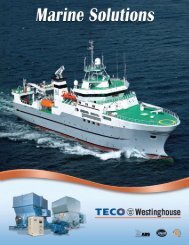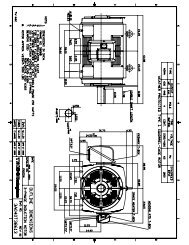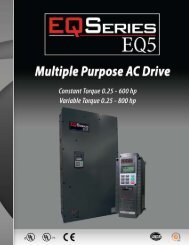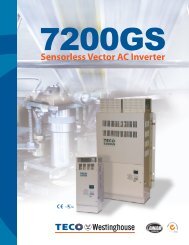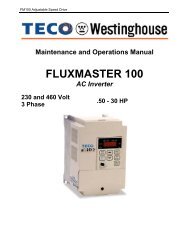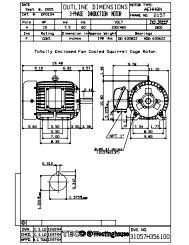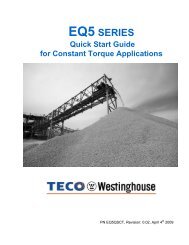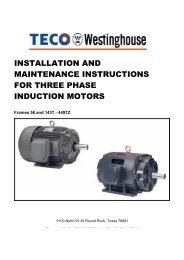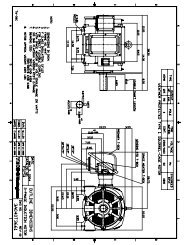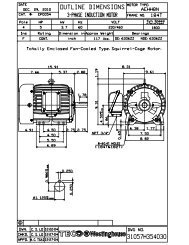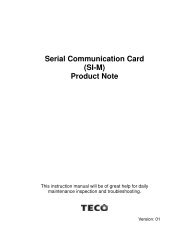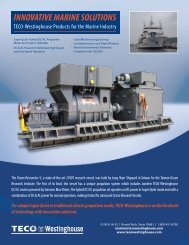EQ7 Series Instruction Manual - TECO-Westinghouse Motor Company
EQ7 Series Instruction Manual - TECO-Westinghouse Motor Company
EQ7 Series Instruction Manual - TECO-Westinghouse Motor Company
You also want an ePaper? Increase the reach of your titles
YUMPU automatically turns print PDFs into web optimized ePapers that Google loves.
4.2.4 P codes (<strong>Motor</strong> 1 Parameters)<br />
The <strong>EQ7</strong> drives the motor under V/f control, dynamic torque control, vector control without speed sensor, or vector<br />
control with speed sensor, which can be selected with function codes.<br />
To use the integrated automatic control functions such as auto torque boost, torque calculation monitoring,<br />
auto-energy saving operation, torque limiter, automatic deceleration (anti-regenerative control), auto search for<br />
idling motor speed, slip compensation, torque vector control, droop control, and overload stop, it is necessary to<br />
build a motor model in the inverter by specifying proper motor parameters including the motor capacity and rated<br />
current.<br />
The <strong>EQ7</strong> provides built-in motor parameters for HP matched motors. To use these motors, it is sufficient to specify<br />
motor parameters for P99 (<strong>Motor</strong> 1 Selection). If the cabling between the inverter and the motor is long (generally,<br />
66 ft (20 m) or longer) or a reactor is inserted between the motor and the inverter, however, the apparent motor<br />
parameters will change, so auto-tuning or other adjustments are necessary. For the auto-tuning procedure, refer<br />
to Chapter 3 "RUNNING THE MOTOR."<br />
When using a motor made by other manufacturers or a non-standard motor, obtain the datasheet of the motor and<br />
specify the motor parameters manually or perform auto-tuning.<br />
To specify the motor parameters correctly, select the motor type with P99 (<strong>Motor</strong> 1 Selection), specify the motor<br />
rated capacity with P02, and then initialize the motor parameters with H03. This procedure also applies when the<br />
inverter is switched to the MD/HD mode and a motor with one or two ranks lower capacity is used. When switching<br />
the motor between the 1st to 4th motors, specify the corresponding function codes. (Refer to the description of<br />
A42.)<br />
The motor parameters to be specified in P13 through P56 (such as iron loss factors and magnetic saturation<br />
factors) are usually not shown on the motor nameplate or in the test report.<br />
If auto-tuning (P04 = 2 or 3) is not performed, it is not necessary to change the motor parameters from the ones for<br />
a standard motor.<br />
P01<br />
<strong>Motor</strong> 1 (No. of poles)<br />
P01 specifies the number of poles of the motor. Enter the value given on the nameplate of the motor. This setting<br />
is used to monitor the motor speed (see E43) and control the speed. The following expression is used for the<br />
conversion.<br />
<strong>Motor</strong> speed (r/min) =<br />
120<br />
No. of poles<br />
Frequency (Hz)<br />
- Data setting range: 2 to 22 (poles)<br />
P02<br />
<strong>Motor</strong> 1 (Rated capacity)<br />
P02 specifies the rated capacity of the motor. Enter the rated value given on the nameplate of the motor.<br />
Data for P02 Unit Function<br />
HP When P99 (<strong>Motor</strong> 1 Selection) = 1<br />
0.01 to 1000<br />
kW When P99 (<strong>Motor</strong> 1 Selection) = 0, 2, 3 or 4<br />
When accessing function code P02 with the keypad, take into account that the P02 data automatically updates the<br />
data of function codes P03, P06 through P23, P53 through P56, and H46.<br />
P03<br />
<strong>Motor</strong> 1 (Rated current)<br />
P03 specifies the rated current of the motor. Enter the rated value given on the nameplate of the motor.<br />
- Data setting range: 0.00 to 2000 (A)<br />
4-109



